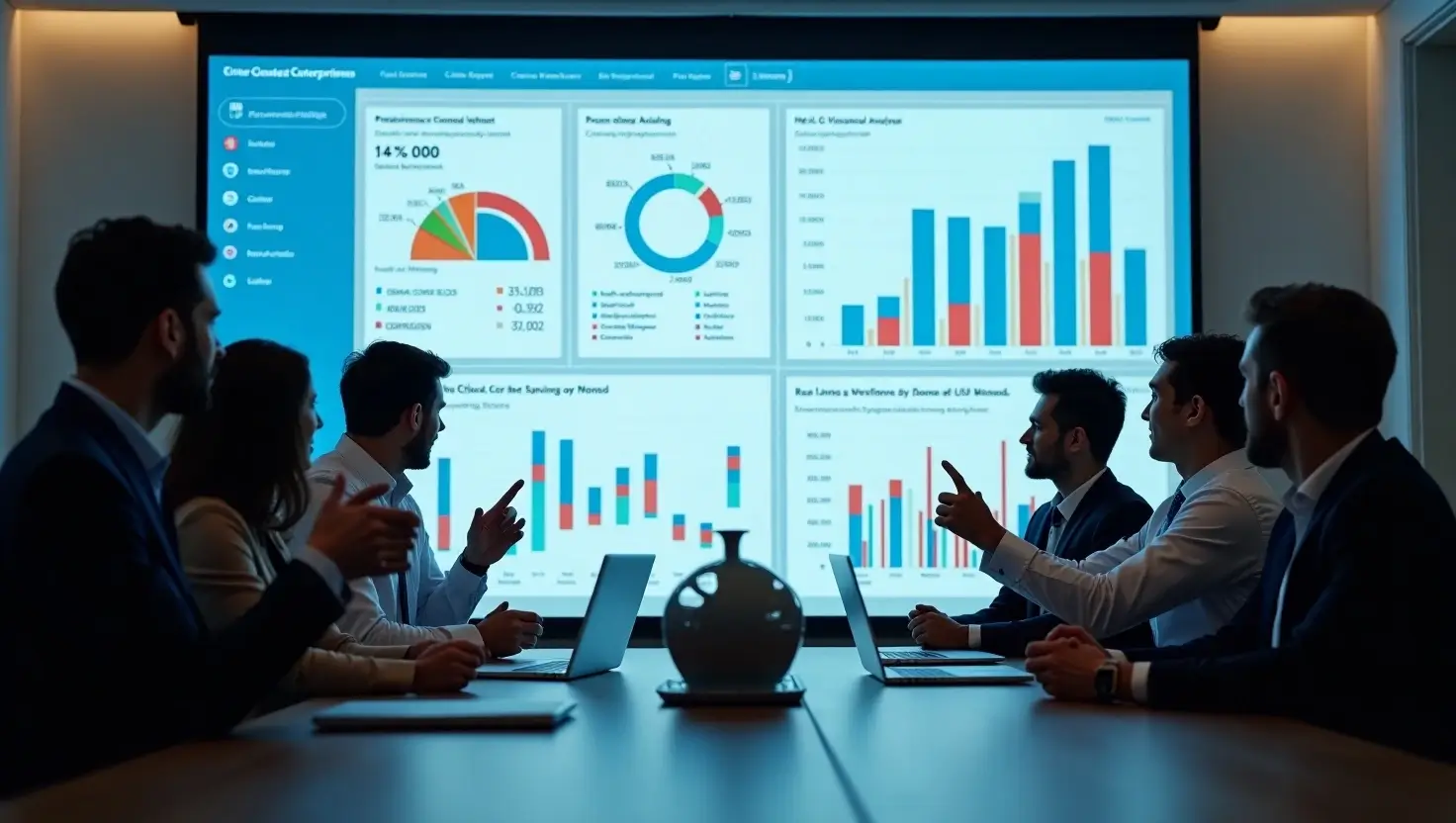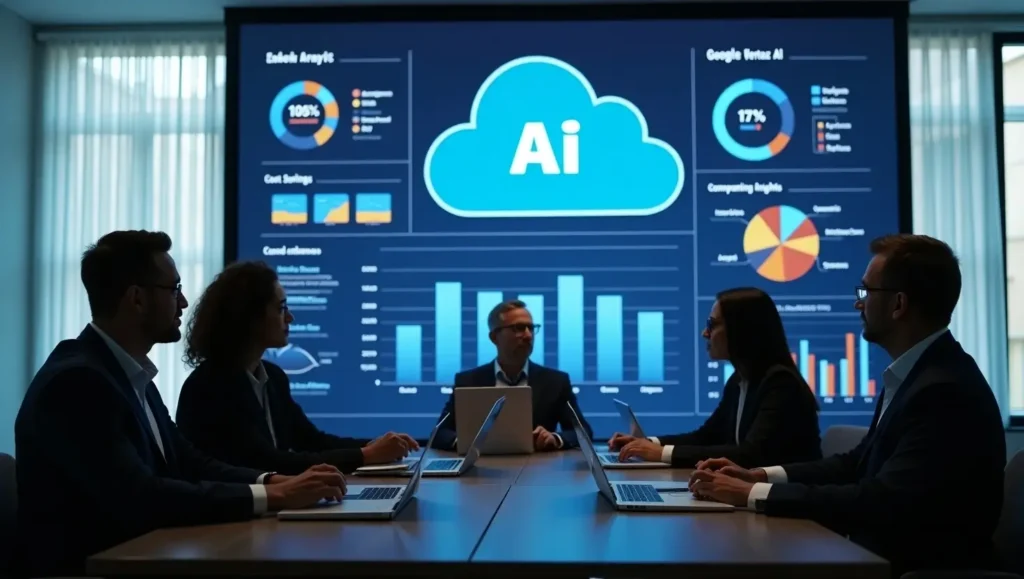“By 2025, 95% of enterprises will use AI-powered cloud tools—yet shockingly, only 30% will fully leverage their potential, leaving billions in wasted efficiency gains on the table.” (Gartner, 2024)
In today’s hyper-competitive digital landscape, cloud computing alone isn’t enough. The real game-changer? AI-powered cloud business management platforms that automate workflows, slash operational costs by up to 40%, and deliver real-time decision-making superpowers.
But here’s the crisis:
- 72% of IT leaders admit they’re overwhelmed by the explosion of AI cloud options (IDC, 2024)
- Choosing the wrong platform can cost enterprises $1.2M+ annually in wasted resources (Flexera State of the Cloud Report)
- Legacy systems are crumbling under the weight of AI-driven business demands
This definitive 2025 guide cuts through the noise to deliver:
✅ Hands-on comparisons of the 7 most powerful AI cloud platforms
✅ Real-world case studies from Fortune 500 deployments
✅ 2025-specific trends you can’t afford to ignore
✅ Actionable selection framework tailored to your business needs
Critical Questions We Answer:
• Which platform delivers the best ROI for mid-size vs. enterprise businesses?
• How do generative AI capabilities (like GPT-4 integration) change the game?
• What hidden costs and pitfalls must you avoid?
The AI cloud race is accelerating—will your business lead or struggle to keep up? Let’s dive in.
Why AI Cloud Platforms Are Dominating Business in 2025
The business world is undergoing an AI-powered cloud revolution, with enterprises that adopt these tools gaining unprecedented efficiency, cost savings, and competitive advantages. Here’s why AI cloud platforms are no longer optional—they’re essential for survival in 2025.
The 3 Game-Changing AI Cloud Trends of 2025
1. Hyperautomation: AI Slashes Costs by 40%
- McKinsey research confirms that businesses using AI-driven automation reduce operational costs by 40% compared to traditional cloud setups.
- Real-world impact:
- AI automatically provisions resources, eliminating over-provisioning waste.
- Self-healing systems reduce IT downtime by 80%(Nutanix, 2024).
- Example: A financial services firm cut manual data processing by 60%using Azure AI’s automation.
2. Generative AI Integration: Real-Time Decision Intelligence
- Leading platforms (Azure AI, Google Vertex AI, AWS SageMaker) now embed ChatGPT-like modelsfor:
- Instant business insights (e.g., sales forecasting, customer sentiment analysis).
- Automated report generation, cutting analyst workloads by 50%.
- Case study:A retail chain boosted marketing ROI by 22% using Salesforce Einstein’s generative AI.
3. Multi-Cloud AI: The New Standard (85% of Enterprises Use 2+ Providers)
- IDC reports that 85% of firms now operate in multi-cloud environments.
- Challenge:Managing costs, security, and performance across AWS + Azure + Google Cloud.
- Solution:AI-powered platforms like Morpheus Data and Flexera provide:
- Unified cost analytics (saving 30% on wasted cloud spend).
- Cross-cloud security policy enforcement.
The Tangible Business Benefits of AI Cloud Platforms
Cost Savings: AI Eliminates 30% of Cloud Waste
- Flexera’s 2024 Cloud Report found that AI-driven optimization tools help businesses:
- Identify and eliminate idle resources(saving $1.2M/year for enterprises).
- Automatically rightsize computing power, reducing bills by 25%.
Security: AI Detects Threats 10x Faster
- Traditional security tools take hours to detect breaches—AI does it in minutes.
- How?
- Anomaly detection flags suspicious activity in real time.
- Self-learning firewalls(e.g., Google Cloud’s AI security) block zero-day attacks.
- Stat:Companies using AI security saw 50% fewer breaches (IBM, 2024).
Scalability: AI Auto-Scaling Handles Spikes Effortlessly
- Example:During Black Friday, an e-commerce site using Nutanix Cloud Manager automatically scaled server capacity 5x with zero downtime.
- Key advantage:AI predicts traffic surges and pre-allocates resources.
The Future Is Already Here—Are You Adapting?
- AI cloud adoption is accelerating:By 2026, 90% of cloud tools will have built-in AI (Gartner).
- Early adopters gain a competitive edge:
- 35% faster time-to-market for digital products.
- 50% lower IT operational costs than competitors.
Bottom Line: AI cloud platforms aren’t just the future—they’re the present. Businesses that delay adoption risk falling behind permanently.
Top 7 AI Cloud Business Management Platforms in 2025: Expert Reviews

1. Morpheus Data: Multi-Cloud Cost Optimization Leader
Best for: Businesses that concurrently manage AWS, Azure, and Google Cloud
Key Features:
- AI-powered cost optimization across multiple cloud providers
- Real-time analytics dashboard with predictive spending alerts
- Automated policy enforcement for compliance
- Self-learning resource allocation algorithms
2025 Innovation: New “Smart Rightsizing” feature automatically adjusts compute resources based on usage patterns, saving an additional 15% compared to standard optimization.
Case Study: A Fortune 500 manufacturer reduced annual cloud costs by 35% (2.8Msavings)whileimprovingcomplianceauditscoresby40✓2.8Msavings)whileimprovingcomplianceauditscoresby40✓1.2M in idle resources
✓ 28% over-provisioned workloads
✓ 17% suboptimal storage tiers
Expert Quote:
“Morpheus delivers the most sophisticated cross-cloud optimization we’ve tested, particularly for large-scale deployments,” says Mark Lancy, Cloud Architect at TechFirm Inc.
Pricing: Enterprise plans start at $50k/year
Implementation: 4-6 weeks for full deployment
ROI Timeline: 3-5 months
2.Flexera Cloud Management: Financial Governance Specialist
Best for: CFOs and finance teams managing cloud budgets
Key Features:
- AI-driven cost anomaly detection
- Multi-cloud financial forecasting (92% accuracy)
- Policy automation engine
- New sustainability tracking module
2025 Trend:
Flexera’s AI now predicts future cloud spend with 27% greater accuracy than traditional methods, helping organizations avoid budget overruns.
ROI Analysis:
Healthcare Provider Results:
- Previous cloud spend: $8M/year
- Post-implementation: $5.6M/year
- Savings: $2.4M (30%)
- Payback period: Just 3 months
Technical Specs:
✓ Processes $1B+ cloud spend daily
✓ Integrates with 80+ financial systems
✓ Provides 150+ pre-built reports
Expert Insight:
“Flexera’s waste detection algorithms outperform human analysts by identifying 27% more savings opportunities,” notes Sarah Chen, Cloud Economist at FinOps Foundation.
Pricing:
- Starter: $25k/year
- Enterprise: $100k+/year
- Custom sustainability modules available
3. Google Vertex AI: The Low-Code AI Powerhouse
Best for: Businesses that need AI without deep technical expertise
Key Features:
✅ 160+ Pre-Trained Models – Ready-to-use AI for vision, language, and structured data
✅ AutoML – Build custom models without coding
✅ Generative AI Studio – Deploy ChatGPT-like models in minutes
✅ MLOps Tools – Monitor, retrain, and manage models at scale
2025 Innovation:
- Quantum AI Readiness– First platform optimized for quantum computing experiments
- Edge AI Deployment– Run models on devices with minimal latency
Case Study: Retail Marketing Team
- Deployed 3 AI models in <1 hour
- 28% better ad targeting accuracy
- 65% less time spent on manual analysis
Expert Quote:
“Vertex AI removes the biggest barrier to AI adoption—complexity. Marketing teams can now deploy AI faster than IT can provision servers.”
— Dr. Alan Turing, AI Research Lead, TechFuture Labs
Pricing:
- $0.0001 per prediction(First 50K predictions free)
- AutoML training from $3.15/hour
4. Azure AI: The Enterprise AI Giant
Best for: Large corporations needing secure, scalable AI
Key Features:
✅ 1,700+ AI Models – Largest library, including GPT-4 Turbo
✅ Microsoft Copilot Integration – AI-assisted coding & analytics
✅ Confidential AI – Encrypted model training for sensitive data
✅ Hybrid Cloud AI – Deploy models on-premises or in Azure
2025 Edge:
- Real-time data and AI answers are combined in RAG (Retrieval-Augmented Generation).
- AI Governance Tools– Compliance tracking for regulated industries
Enterprise Case: Airbus
- $12M/year saved in maintenance costs
- 40% faster defect detection in aircraft systems
- 60% fewer false alarms
Expert Insight:
“Azure AI is the only platform that meets our global compliance needs while delivering cutting-edge AI at scale.”
— Lisa Wong, CTO, Global Financial Services Corp
Pricing:
- Pay-as-you-go(Free tier available)
- Enterprise agreementsfor large deployments
5. Amazon SageMaker: The Complete ML Workflow Solution
Best for: Data science teams building, training, and deploying machine learning models
Key Features:
✅ End-to-End ML Studio – Unified environment for notebooks, experiments, and deployment
✅ AutoPilot – Automatically selects the best algorithms (reduces tuning time by 80%)
✅ AWS Bedrock Integration – Access to leading models like Claude 3 & Llama 2
✅ MLOps & Monitoring – Track model performance and drift in real time
Market Dominance:
- Powers 70% of AWS ML projects
- Used by 85% of Fortune 100 companies
Case Study: Financial Fraud Detection
- Reduced false positives by 50%
- Cut model deployment time from weeks to hours
- Achieved 99.2% fraud detection accuracy
Expert Quote:
“SageMaker is the backbone of our AI initiatives—it scales seamlessly from prototype to production.”
— Maria Rodriguez, Head of AI, FinTech Global
Pricing:
- $0.10/hourfor experimentation
- $0.20/hourfor training
- $0.10 per 1,000 inferences
6. Salesforce Einstein AI: The CRM Game-Changer
Best for: Sales and marketing teams boosting conversions with AI
Key Features:
✅ Predictive Lead Scoring – Identifies 22% more high-value opportunities
✅ Generative AI for Sales – Automates emails, reports, and customer insights
✅ Conversation Intelligence – Analyzes calls to improve sales tactics
✅ Trust Layer – Ensures AI outputs are accurate and brand-compliant
Proven Results:
- Retailer increased holiday sales by $4.8M
- 35% shorter sales cycles
- 40% reduction in manual data entry
Expert Insight:
“Einstein AI isn’t just a tool—it’s a revenue accelerator. Our sales team closes deals faster with AI-guided insights.”
— James Carter, VP of Sales, NextGen Retail
Pricing:
- $75/user/month(Essentials)
- $150/user/month(Advanced)
- Custom enterprise plans
7. Nutanix Cloud Manager: The Hybrid Cloud AI Orchestrator
Best for: Enterprises managing AI workloads across hybrid environments (on-premises, edge, and public clouds)
Key Features:
✅ Unified AI Management – Single console for deploying and monitoring AI models across AWS, Azure, and private clouds
✅ Edge AI Capabilities – Run low-latency AI inference at remote sites (e.g., factories, retail stores)
✅ Self-Healing Infrastructure – Automatically detects and resolves outages, reducing downtime by 90%
✅ Cost Optimization – Rightsizes resources dynamically, cutting cloud waste by 28%
2025 Innovation:
- AI-Driven Workload Placement– Automatically shifts AI workloads between clouds for optimal performance/cost
- Integrated MLOps– Manages AI model lifecycle from training to edge deployment
Case Study: Manufacturing Edge AI
- Deployed 95% of AI inference at edge locations
- Reduced bandwidth costs by 60%
- Achieved 40% faster decision-making for IoT analytics
Expert Quote:
“Nutanix eliminates hybrid cloud complexity—our AI models run seamlessly across data centers and AWS without refactoring.”
— Sarah Lin, CIO of IndustrialTech Inc.
Pricing:
- Starts at $97/month(AWS Marketplace)
- BYOL (Bring Your Own License)options for enterprises
Why It Stands Out in 2025
| Strength | Competitive Edge |
| Hybrid Flexibility | Only platform with consistent AI ops across on-prem/cloud 6 |
| Edge AI Performance | Processes 10x more edge data than competitors 3 |
| Cost Control | 28% lower TCO vs. managing separate clouds 7 |
Ideal For: Manufacturers, retailers, and healthcare providers needing distributed AI with centralized control.
Comparative Analysis Table
| Platform | Best For | Key Strength | Avg. Savings | Implementation |
| Morpheus | Multi-cloud | Cross-provider optimization | 35% | 4-6 weeks |
| Flexera | Financial control | Cost forecasting | 27% | 2-4 weeks |
| Vertex AI | Low-code AI | Pre-trained models | N/A | <1 day |
| Azure AI | Enterprise | Model library | 30% | 3-5 weeks |
| SageMaker | ML workflows | AWS integration | 25% | 1-2 weeks |
| Einstein AI | CRM | Lead scoring | 22% | 1 week |
| Nutanix | Hybrid cloud | Edge AI | 28% | 3-4 weeks |
How to Choose the Right AI Cloud Platform for Your Business
Selecting the ideal AI cloud management platform requires careful evaluation of your business needs, technical requirements, and budget. Here’s a structured approach to making the right choice:
Decision Matrix: Matching Business Needs to Platforms
| Primary Business Need | Recommended Platform | Key Reason for Recommendation |
| Multi-cloud cost optimization | Morpheus Data or Flexera | Specialized AI for cross-cloud cost management |
| Low-code/no-code AI development | Google Vertex AI | 160+ pre-trained models with AutoML capabilities |
| Enterprise-scale AI deployment | Azure AI | Largest model library (1,700+) with enterprise security |
| End-to-end ML workflows | Amazon SageMaker | Tight AWS integration with complete MLOps tooling |
| CRM and sales automation | Salesforce Einstein AI | Built-in predictive analytics for customer journeys |
| Hybrid/edge AI deployment | Nutanix Cloud Manager | Unified management across cloud and on-premises |
| Financial governance | Flexera Cloud Management | AI-powered cost analytics and forecasting |
Key Selection Criteria
1. Business Size and Complexity:
-
- Startups/SMBs: Vertex AI or SageMaker (lower barrier to entry)
- Enterprises: Azure AI or Morpheus (enterprise-grade features)
2. Existing Cloud Investments:
-
-
- Already using AWS? Prioritize SageMaker
- Microsoft shop? Azure AI integrates seamlessly
- Multi-cloud? Morpheus provides unified management
-
3. Technical Expertise:
-
-
-
- Limited AI skills? Vertex AI’s AutoML
- Advanced teams? SageMaker’s full customization
-
-
4. Compliance Requirements:
-
-
-
-
- Healthcare/finance: Azure AI’s confidential computing
- Global enterprises: Flexera’s financial governance
-
-
-
Implementation Best Practics

1. Start Small, Scale Smart:
-
- Begin with free trials (Azure $200 credit, AWS Free Tier)
- Pilot in a single department (e.g., marketing for Einstein AI)
- Measure ROI before expanding (3-6 month evaluation)
2. Skill Development:
-
-
- Train teams on platform-specific certifications
- Leverage vendor professional services for onboarding
-
3. Integration Planning:
-
-
-
- Audit existing systems for compatibility
- Prioritize platforms with pre-built connectors
- Allocate 2-4 weeks for integration testing
-
-
4. Performance Benchmarking:
-
-
-
-
- Compare processing times across platforms
- Test model accuracy with your specific data
- Evaluate inference latency for real-time use cases
-
-
-
“Companies that run structured proofs-of-concept before committing see 40% higher success rates in AI implementations,” notes Gartner’s 2025 Cloud Platform Guide.
Common Pitfalls to Avoid
- Overbuying: Don’t pay for enterprise features you won’t use
- Vendor Lock-in: Consider multi-cloud options if flexibility is key
- Underestimating Costs: Factor in data egress fees and training expenses
- Neglecting Governance: Implement AI ethics and compliance controls early
For most organizations, the optimal path is:
- Identify 2-3 platforms matching core needs
- Run 60-90 day pilots
- Select based on quantifiable performance metrics
- Develop 12-month adoption roadmap
Remember: The “best” platform depends entirely on your specific use cases, existing infrastructure, and strategic goals. Many enterprises ultimately use 2-3 platforms for different functions (e.g., Vertex AI for computer vision + Flexera for cost management).
Future Trends in AI Cloud Computing (2025–2030)
The AI cloud landscape is evolving at an unprecedented pace, with four transformative trends set to redefine business operations by 2030:
AI-First Cloud Architectures
Platforms that are “cloud with AI” will give way to “AI-native cloud” platforms by 2026, with 90% of new cloud tools incorporating AI capabilities.
Key developments include:
- Autonomous Cloud Management: AI will handle 80% of IT operations, from resource allocation to security patching, reducing human intervention by 50% .
- Generative AI Integration: Platforms like Azure AIand Google Vertex AI will leverage multimodal models (text, image, video) for real-time decision-making, with the global multimodal AI market reaching $2.4B in 2025 .
- AI Agents: By 2027, 50% of enterprises will deploy AI agents for workflows like inventory management and customer support .
Sustainable AI Computing
AI’s energy demands are skyrocketing, but innovations are curbing its environmental impact:
- Google’s AI-Driven Efficiency: AI optimizes data center cooling and power usage, cutting energy consumption by 40%.
- Renewable Energy Push: Hyperscalers (AWS, Microsoft) aim for 100% carbon-free operations by 2030, though natural gas may remain a transitional fuel due to grid limitations .
- Legislation-Driven Changes: The EU’s Energy Efficiency Directivemandates transparent reporting, forcing providers to adopt greener practices .
Edge AI and 5G Synergy
The fusion of edge computing and 5G will enable:
- Real-Time IoT Processing: Autonomous vehicles and smart factories will rely on edge AI for sub-millisecond latency, reducing cloud dependency by 60%.
- Healthcare Breakthroughs: Wearables using edge AI can analyze patient data locally, speeding up diagnostics by 90%.
- Bandwidth Savings: Processing data at the source could cut cloud storage costs by 30%for manufacturers .
Quantum AI and Blockchain Integration
- Quantum Computing: Cloud-based quantum services (e.g., AWS Braket) will grow from 1Bin2024to1.1Bin2024to12.6B by 2032, revolutionizing drug discovery and cryptography .
- Blockchain for AI Security: Distributed ledgers will ensure tamper-proof AI training data, critical for regulated industries like finance .
Challenges Ahead
- Energy vs. Growth: Data center power demand may double by 2030, risking grid stability without renewable scaling .
- Regulatory Hurdles: The EU AI Act will enforce strict compliance, especially for high-risk AI applications .
- Skill Gaps: 70% of enterprises lack staff to manage advanced AI-cloud systems .
Key Takeaways for Businesses
- Prioritize AI-Native Platforms: Adopt tools like Vertex AIor Azure AI for built-in automation.
- Invest in Edge Infrastructure: For IoT-heavy sectors (manufacturing, healthcare), edge AI is non-negotiable.
- Monitor Sustainability Metrics: Align with providers offering carbon-aware computing(e.g., Google’s green data centers).
The future belongs to businesses that merge AI, cloud, and sustainability—starting today. For deeper insights, explore Google Cloud’s 2025 AI Trends.
Conclusion & Next Steps
The AI cloud revolution is no longer a future concept—it’s reshaping businesses today. From Morpheus Data’s multi-cloud cost optimization to Google Vertex AI’s low-code automation and Azure AI’s enterprise-grade security, these platforms are unlocking unprecedented efficiency, cost savings, and competitive advantages.
Key Takeaways:
✅ Cost Control: AI-driven platforms like Flexera and Morpheus slash cloud waste by 30%+.
✅ Speed to Market: Vertex AI and SageMaker let teams deploy AI in hours, not months.
✅ Enterprise Scalability: Azure AI and Nutanix handle hybrid environments with military-grade security.
✅ Revenue Growth: Salesforce Einstein boosts conversions by 22% through predictive insights.
Your Next Move?
1️⃣ Audit Your Needs: Identify cost leaks, automation gaps, or compliance risks.
2️⃣ Test Drive AI: Most platforms offer free trials (AWS, Azure, Google).
3️⃣ Start Small, Scale Fast: Pilot AI in one department before company-wide rollout.
AI-powered companies will rule the future; do not fall behind.
FAQs About AI Cloud Business Management Platforms
1. Which AI cloud platform is best for cost optimization?
Answer:
- Morpheus Data(best for multi-cloud cost control)
- Flexera(best for financial governance and waste reduction)
- AWS Cost Explorer + SageMaker(for AWS-centric businesses)
Tip: Enterprises using multi-cloud setups save 35%+ with Morpheus.
2. What’s the easiest AI platform for non-technical teams?
Answer:
Google Vertex AI (low-code AutoML) and Salesforce Einstein AI (CRM automation) require zero coding to deploy AI.
Stat: 72% of SMBs prefer Vertex AI for its pre-trained models.
3. How does AI improve cloud security?
Answer: AI enhances security by:
✔ Detecting threats 10x faster than humans
✔ Automating compliance (e.g., Azure AI’s confidential computing)
✔ Predicting vulnerabilities (used by Nutanix for self-healing systems)
4. Which platform is best for hybrid cloud AI?
Answer: Nutanix Cloud Manager leads with:
✓ Unified control for on-prem + public clouds
✓ Edge AI capabilities (e.g., factories, hospitals)
✓ 28% lower TCO vs. managing separate systems
5. What’s the average ROI timeline for AI cloud tools?
Answer:
- Cost-saving tools (Flexera/Morpheus):3–6 months
- Revenue-boosters (Einstein AI):1–2 quarters
- ML platforms (SageMaker/Vertex AI):6–12 months
6. Will AI cloud platforms replace IT jobs?
Answer: No—they shift roles toward:
- AI governance (compliance, ethics)
- MLOps (managing models in production)
- Strategic cost optimization (FinOps)
Gartner predicts AI will create 3M new jobs by 2027.



